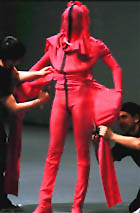 |
 |
 |
 |
 |
 |
|||||
 |
 |
 |
 |
|
TOKYO FASHION: 1999-2000 Fall/Winter Collection July 2, 1999  The new Tokyo fashions are pointing the way to very different concepts of clothes. (FUJITSUKA Mitsumasa, ISSEY MIYAKE INC.) The Tokyo fashion scene is developing a worldly flavor. Designers recently unveiled their 1999-2000 fall/winter collections to the public in several shows throughout greater Tokyo. In addition to unconventional styles by veteran designers, including garments that wearers cut from a large piece of cloth and non-sewn clothing, convincing offerings from a new crop of young talent suggested the arrival of a new era in Japanese fashion. A New Concept of Clothing One new style, fittingly named A-POC (A Piece of Cloth), by designer Issey Miyake is actually nothing more than a long, rectangular piece of knit fabric. The wearer cuts out patterns marked on the cloth with dotted lines to create an assortment of dresses, hats, gloves, socks, and even purses. Depending on how the fabric is cut, shirts, skirts, or even one-piece garments can emerge. Even the length of the sleeves is left to the discretion of the wearer, so a sleeveless cut might leave enough fabric for a pair of long gloves. The stitched lines themselves have an artful look, but the computer-rendered patterns are designed to minimize wasted fabric. When the flat pieces of cloth are draped over the body they seem to come to life, vibrantly accenting the wearer's figure. "Communication between designer and wearer occurs through the clothes themselves," says Miyake. "I plan to continue to develop garments with a range of possibilities, that the wearer can fabricate into a variety of designs." An offering by fashion designer Rei Kawakubo (Comme des Garcons) also incorporates a single, flat piece of fabric, but is based on a totally different concept. The cloth has a few openings, and is decorated in several areas with tiny darts, barely discernible to the eye, around which the garment gathers and swells. When a wearer puts her arms through the openings and wraps it around her body, what was a flat, inanimate piece of cloth suddenly becomes a flowing garment. Last season, Kawakubo's designs pursued elegant simplicity to such an extent that they appeared to be unadorned prototypes; this time around she has taken this simplicity a step further, evoking a feeling of ease and freedom with a piece so amorphous it seems to lack even a basic shape. Reversible Fashion Other young standouts include Keiji Wakabayashi (National Standard), whose work features slick redesigning of common garments like duffle coats and slim jackets; Yoichi Nagasawa (No Concept But Good Sense), who employs a bright, pop style; Koichi Chida (Eupepomboo), a creator of basic, sporty designs; and Masako Saso and Yukiko Kurahashi (Body Butter). As a whole, the collections display a trendy street sensibility without being overly ambitious in design, resulting in clothing suitable even for daily wear by female office workers or housewives. With impressive offerings like these, the next task for these designers is to spread the appeal of the "Tokyo Brand," distinct from the fashions found on the runways of Paris or Milan, to the rest of the world.
|

